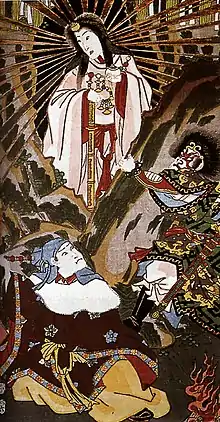
Shinmei shrines (Japanese: 神明神社, lit. 'Shrine of deity') are shrines dedicated to the worship of the Japanese solar deity Amaterasu. The head Shinmei shrine is Ise Grand Shrine which inspired the Shinmei-zukuri architectural style.
History
The solar goddess of Shinto, Amaterasu Omikami, is considered to be the ancestral deity of the Imperial House of Japan, and is widely worshiped in agricultural rituals. During the Kofun Period, a number of Shinmei Shrines, such as Ise Grand Shrine, were constructed and dedicated to Amaterasu. In national rituals, only the emperor was permitted to make offerings towards the deity.[1]
However, as the power of the imperial court declined in the middle of the Heian Period, the central government could no longer financially support the Shinmei Shrines. As a result, the responsibilities of their maintenance fell onto local feudal lords, who were also given the right to relay prayers. Local lords donated part of their own estates (Shōen) as Shinryo (Japanese: 神領, lit. 'Domain of gods') to construct shrines dedicated to Amaterasu, including Nishina Shinmei Shrine in Ōmachi, Shinmei Shrine in Yokohama, and Amatsu Shinmei Shrine in Kamogawa. Some of the Shinmei Shrines, such as the Shiba Great Shrine, were said to have predated the Shōen System.[2]
The priests of Shinmei Shrines, also known as Oshi (Japanese: 御師, lit. 'Royal teacher'), temporarily enshrined the talisman Jingū Taima in their branch offices in the eastern part of Japan, and some of these offices later developed into Shinmei Shrines as well.[3]
During the Kamakura and later Muromachi Periods, Oshi's influence began to spread among both high-ranking samurai class and the common people.[4] Especially in Kyoto, an increasing number of shrines outside of the traditional Shinryo were given permission by Oshi to enshrine Amaterasu. These shrines came to be known as "Imashinmei" (Japanese: 今神明, lit. 'Current Shinmei') or "Hishinmei" (Japanese: 飛神明, lit. 'Flying Shinmei').[5] In the Edo Period, the Ise faith became even more popular, spreading throughout the country and permeating a wide range of social classes.[6] In 1632, Ise Shrine published the Ise Calendar in 1632, which recorded dates for agricultural activities and was widely used before the Meiji Restoration.[7] As the influence of Ise Shrine and its deity Amaterasu grew, the number of Shinmei Shrines increased further.
Major shrines
Major Shimei Shrines can be seen in the following table:
| Region | Location | Shrine Name (ja) | Shrine Name (en) |
|---|---|---|---|
| Hokkaido | Hakodate | 山上大神宮 | Yamanoue Great Shrine |
| Hokkaido | Ashibetsu | 蘆別神社 | Ashibetsu Shrine |
| Hokkaido | Matsumae | 徳山大神宮 | Tokuyama Great Shrine |
| Hokkaido | Esashi | 姥神大神宮 | Ubagami Great Shrine |
| Tōhoku | Goshogawara, Aomori | 神明宮 | Shinmei Shrine |
| Tōhoku | Ichinoseki, Iwate | 御嶽山御嶽神明社 | Ontakesan Ontake Shinmei Shrine |
| Tōhoku | Ōshū, Iwate | 神明神社 | Shinmei Shrine |
| Tōhoku | Sendai, Miyagi | 櫻岡大神宮 | Sakura Gaoka Great Shrine |
| Tōhoku | Misato, Miyagi | 木間塚神明社 | Kimatsuka Shinmei Shrine |
| Tōhoku | Shiroishi, Miyagi | 神明社 | Shinmei Shrine |
| Tōhoku | Akita, Akita | 土崎神明社 | Tsuchizaki Shinmei Shrine |
| Tōhoku | Ōdate, Akita | 大館神明社 | Ōdate Shinmei Shrine |
| Tōhoku | Ōdate, Akita | 扇田神明社 | Ōgita Shinmei Shrine |
| Tōhoku | Semboku, Akita | 角馆总镇树神明社 | Kakunodate Sōchinju Shinmei Shrine |
| Tōhoku | Gojōme, Akita | 五城目神明社 | Gojōme Shinmei Shrine |
| Tōhoku | Yamagata, Yamagata | 神明神社 | Shinmei Shrine |
| Tōhoku | Aizuwakamatsu, Fukushima | 神明神社 | Shinmei Shrine |
| Tōhoku | Kōriyama, Fukushima | 開成山大神宮 | Kaiseizan Great Shrine |
| Kantō | Itako, Ibaraki | 神明神社 | Shinmei Shrine |
| Kantō | Tochigi, Tochigi | 神明宫 | Shinmei Shrine |
| Kantō | Tokorozawa, Saitama | 所澤神明社 | Tokorozawa Shinmei Shrine |
| Kantō | Sōka, Saitama | 神明宫 | Shinmei Shrine |
| Kantō | Hannō, Saitama | 神明神社 | Shinmei Shrine |
| Kantō | Ageo, Saitama | 神明神社 | Shinmei Shrine |
| Kantō | Kuki, Saitama | 神明神社 | Shinmei Shrine |
| Kantō | Satte, Saitama | 神明神社 | Shinmei Shrine |
| Kantō | Hasunuma, Saitama | 神明神社 | Shinmei Shrine |
| Kantō | Minaminakamaru, Saitama | 神明神社 | Shinmei Shrine |
| Kantō | Mikura, Saitama | 神明神社 | Shinmei Shrine |
| Kantō | Tsukamoto, Saitama | 神明神社 | Shinmei Shrine |
| Kantō | Kagiage, Saitama | 神明社 | Shinmei Shrine |
| Kantō | Torochō, Saitama | 神明社 | Shinmei Shrine |
References
Bibliography
- Kawamori, Shōji (1985). 伊勢神宮と武家社会 [Ise Jingu Shrine and Samurai Society] (in Japanese). Hiroshima University.
- Nishigaki, Seiji, ed. (1983). お伊勢参り [Visiting Ise]. Iwanami shinsho (in Japanese). Tōkyō: Iwanami shoten. ISBN 978-4-00-420252-3.
- Seta, Katsuya (1985). 伊勢の神をめぐる病と信仰 [Illness and Belief Concerning Gods of Ise] (in Japanese). Yuzankaku, Inc.
- Shinjo, Tsunezo (1949). 社寺と交通 熊野詣でと伊勢参り [Shrines and Transportation, Kumano Pilgrimage and Ise Pilgrimage] (in Japanese). Shibundo Co., Ltd.
